The Big Muff π Page
The Definitive Big Muff Resource and History
VISIT MY SWORDS, KNIVES and FANTASY ART WEBSITE www.kitrae.net
©Kit Rae. Last update February 2024
PART 1 • PART 2 • PART 3 • PART 4
WHY ARE THE TRANSISTORS LABELED IN THE REVERSE ORDER? - Note that Q1-Q4 and D1-D4 are labeled in reverse order from input to output on these schematics than they are on a typical schematic. This is due to the fact that they are printed in this order on the actial V1, V2, and V3 Big Muff PCB's. To keep it from being confusing for those reading their PCBs, since this is primarily a reference for vintage Big Muff owners, and to keep the EH tradition, we have used this order on all Big Muff schematics, including post 1980's Big Muffs and clones. I have also tried to keep the part numbers consistent from schematic to schematic.
MAXON D&S / IBANEZ OVERDRIVE Second Series, modified Violet Ram's Head Big Muff - An update to Maxon's mid 1970s OD-801 Big Muff clone (shown on page 1), also sold in an Ibanez branded version, the OD-850. This is a trace of my square button version, circa 1979-80, with the FET bypass switching section removed. Looking at just the BMP section of this circuit you will find it is different from the '74 circuit. This one is an exact clone of a 1973 "violet" era Ram's Head Big Muff variant, with the exception of one slight pathway mod in the tone section. Minor changes were made to the circuit for the next several years. Maxon used the same pcbs in a variety of different enclosures, marketed as the Maxon OD-801, Maxon MD-9, Maxon Jet Driver JD-01, Maxon Magnum Distortion MD-9, Ibanez Double Sound (second version), Ibanez Overdrive OD-9. The Ibanez 60's Fuzz Soundtank SF5 and FZ5 were also variations of this circuit.
I have written more about Maxon and the Maxon/Ibanez Big Muff clones here.
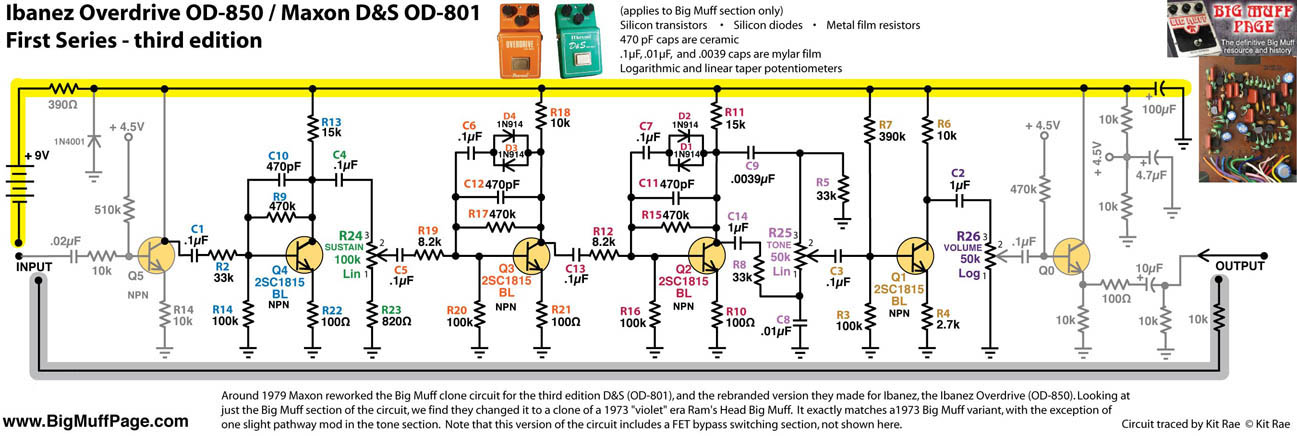
VERSION 7 SOVTEK BIG MUFF PI - 3 circuit variants exist, each made in extended manufacturing runs.
The RED ARMY OVERDRIVE and Version 7 "CIVIL WAR" BIG MUFF PI - After several years of being out of production, around 1991 Electro-Harmonix returned to the market with the Russian made Sovtek Big Muffs. The same pedal was branded as both the Big Muff Pi and as the Red Army Overdrive, sold simultaneously. The circuit did not follow the schematic of any previous version, but rather was a reinvented set of component values, giving it a whole new twist on the tone. It was given larger value 390Ω emitter resistors (rather than typical 100-150Ω) for a lower gain sound, and a slightly less mid scooped tone stack. The small .047µF clipping caps at C6 and C7 (usually 1µF) gave these a fat, thunderous bottom end.
Two versions of the circuit were made, shown below, but the only difference was the feedback/filter capacitors at R9, C11, and C12. First editions had 430pF caps, but later changed to 0.5nF/500pF (two 1nF caps in series) for the second edition. Using the caps in series is a strange oddity for the Russian Big Muffs. The reason for this could have been simply due to the factory having a surplus of 1nF caps, but there were several cap types used through the years, indicating that was not the reason. It is more likely that 500pF caps were simply not available, so the factory opted for series caps equating to that value. It makes no difference to the sound if series caps, or a single cap equal to the series value is used.
Notice that an effect on LED has been added to the circuit (a first for a Big Muff) with a limiting resistor at R1 to keep the 9v from burning out the LED.
The Russian transistors were T018 cased, marked KT3102E 9108, or unmarked TO92 packages. NPN 2N5089 or 2N5210 are near equivalents. The original Silicon diodes used were Russian KD521A and KD521V types, no longer made. IN914 (shown on the schematic) or 1N4148 are approximate modern equivalents, but are not identical. The differences are minor, but diode types do affect the sound frequencies that are clipped.
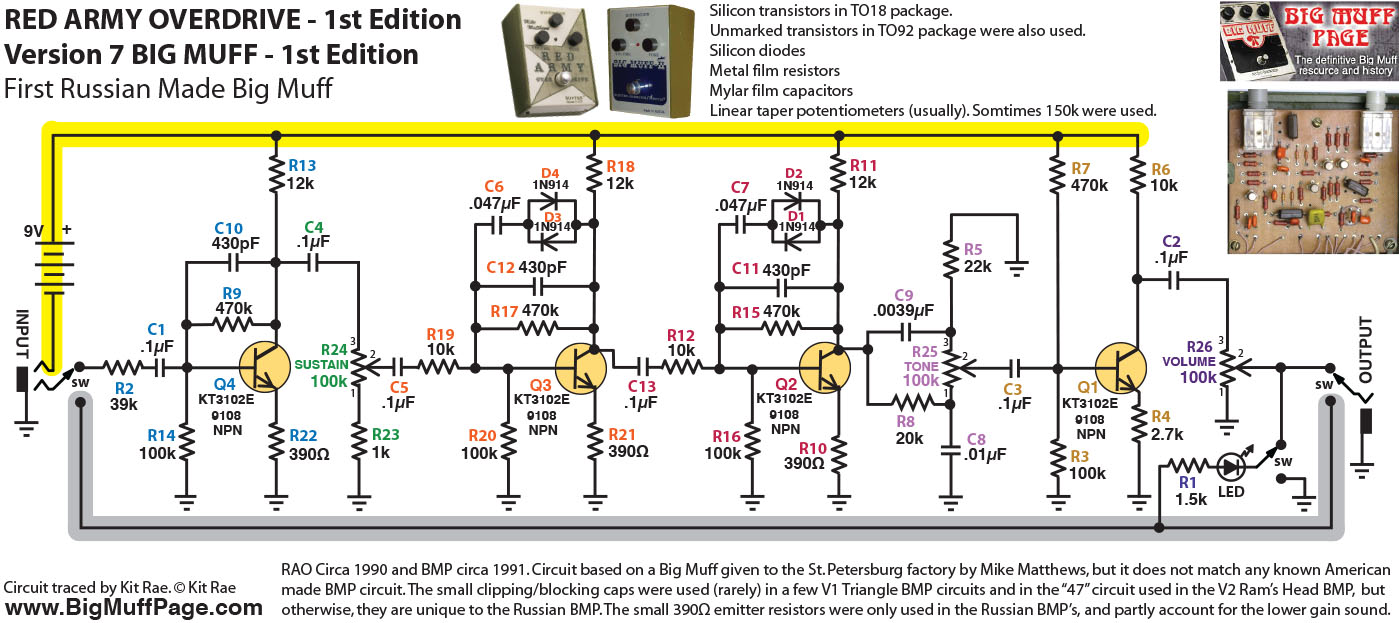
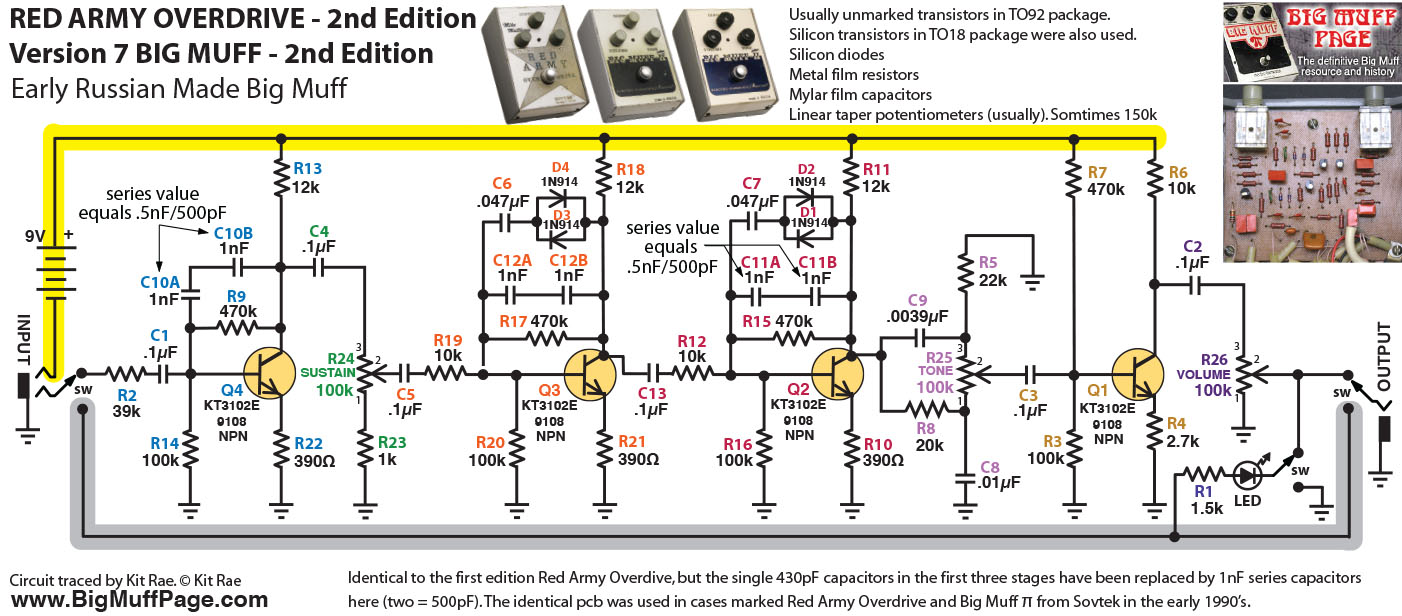
V7B GREEN CIVIL WAR, and 7C GREEN RUSSIAN "TALL FONT" - Identical to the 2nd Edition schematic shown above, but a polarized 22uF power supply filter cap was added to the 9V rail at C14, and the 1.5k resistor for the LED was moved off board to the foot switch or at the LED base, neither of which matter to the tone. The 0.5nF/500pF (two 1nF caps in series) feedback/filter capacitors remained the standard for the first three stages, but sometimes a single 0.5nF/500pF cap was used instead and the holes for the missing caps were jumpered with a wire.. I have also seen a few with a 22k low pass resistor in the tone section at R8, like the high pass, but almost all were 20k. The input capacitor was occasionally 43k rather than the standard 39k. Transistors were unmarked TO92, or TO18 cases marked KT3102E 9108. A close equivalent is the modern 2N5089. The Russian transistors were T018 cased, marked KT3102E 9108, or unmarked TO92 packages. NPN 2N5089 or 2N5210 are near equivalents. The original Silicon diodes used were Russian KD521A, KD521V, 2D510A, all no longer made. IN914 (shown on the schematic) or 1N4148 are approximate modern equivalents, but are not identical. The differences are minor, but diode types do affect the sound frequencies that are clipped.
Sovteks were only powered by batteries, which are a clean source of DC power and do not require filtering to remove the stray DC that can leak into the audio signal from unregulated AC power adaptors, so it is odd that E-H added power supply filtering at C14. Perhaps this was added because AC adaptors were becoming available that allowed them to be connected directly to the 9v battery snaps. Since some wall warts (AC to DC power adaptors) do not regulate and filter properly it is necessary to add some filtering to the circuit. Wall warts convert AC to DC using a bridge rectifier, but some of that rippling alternating current can still leak through the power supply rail into the direct current, creating 60 cycle hum noise in the audio signal. big electrolytic cap on the +9v power supply at C14 was added to smoothly filter the AC ripple by draining the ripple peaks to ground, leaving (mostly) straight DC going through the circuit.
I have seen a lot of marketing for green Russian BMP clones that imply there is a difference in the Tall Font and previous Civil War circuits. To make it clear, as stated above, there was a 1st and a 2nd edition V7 circuit, with the only difference being the feedback/filter caps. Sovteks with Civil War graphics used 430pF or 500pF. Green Civil War Sovteks, and Tall Fonts only used 500pF. That is the only difference. Part tolerances come into play where the sound is concerned, but the schematics were the same. I have owned dozens of these and they all sound slightly different from each other. Oddly enough, the parts I have measured are actually not that far out of spec from the printed values. Variances in the different diode spec's may have more to do with it..
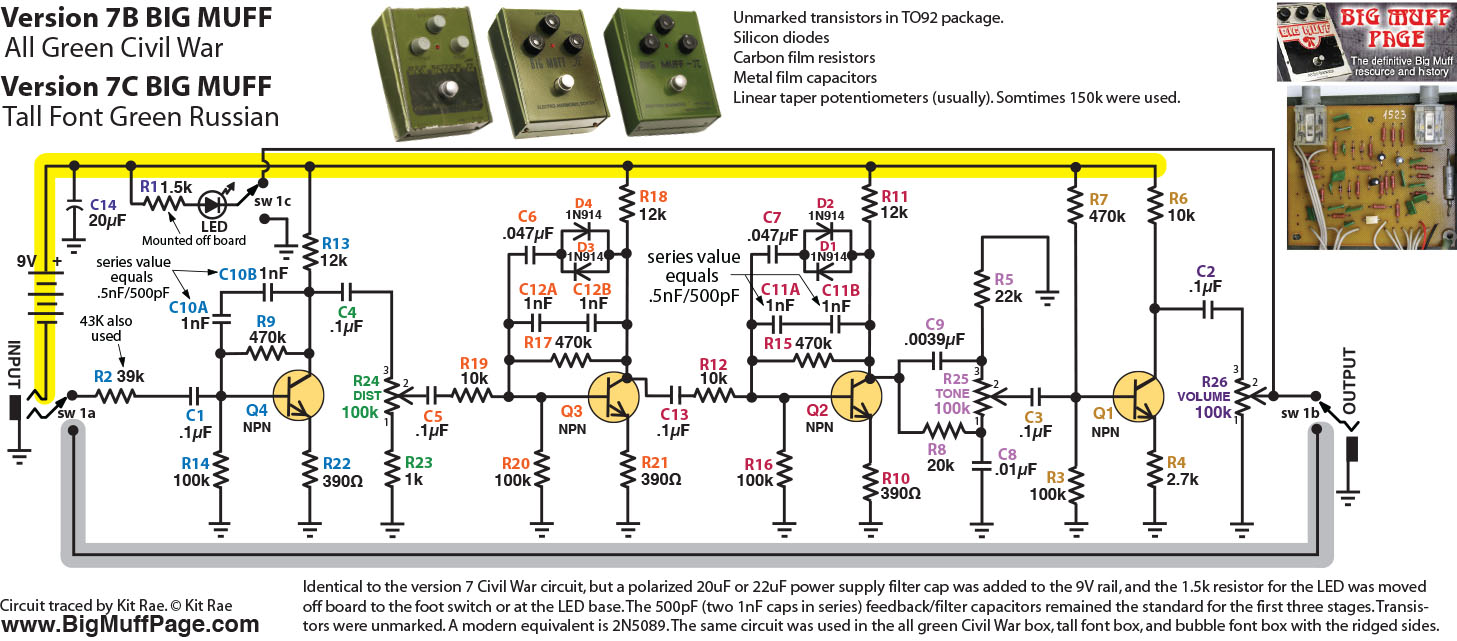
V7C GREEN RUSSIAN "BUBBLE FONT", 7D BLACK RUSSIAN, and SMALL BOX BLACK RUSSIAN BIG MUFF PI - Although there were several different pcb layouts used for these versions, they all followed the exact same schematic, with the rare resistor value change for one of a similar value. The only real difference from the previous Tall Font version was changing the two 1nF series (500pF total) feedback/filter capacitors in the first three stages at C10, C11, and C12, to single 470pF caps like the USA made Big Muffs. A slight bit more grit, and less smooth. R8 was sometimes 39k, but rarely. Some early black boxed V7's have 430Ω emitter resistors at R22/21/10 (rather than 390Ω). The transistors used were Russian 3102EM, 549C or 547C. The original Silicon diodes used in the green Civil War and Tall Font versions were Russian 2D510A, and a type marked with a black band and black dot, all no longer made. The diodes in the Bubble Font version and Black Russians were KD522B. IN914 (shown on the schematic) or 1N4148 are approximate modern equivalents, but are not identical. The differences are minor, but diode types do affect the sound frequencies that are clipped.
The sound difference between this version and the previous Tall Font version was minimal, but us Big Muff cork sniffers hear it. The parts kept getting cheaper, and the enclosures thinner and smaller as the years went by, so EHX gave it the axe. It was replaced with the excellent Bass Big Muff, which is a similar circuit, although not identical. The Deluxe Bass Big Muff was an upgrade to the Bass Big Muff.
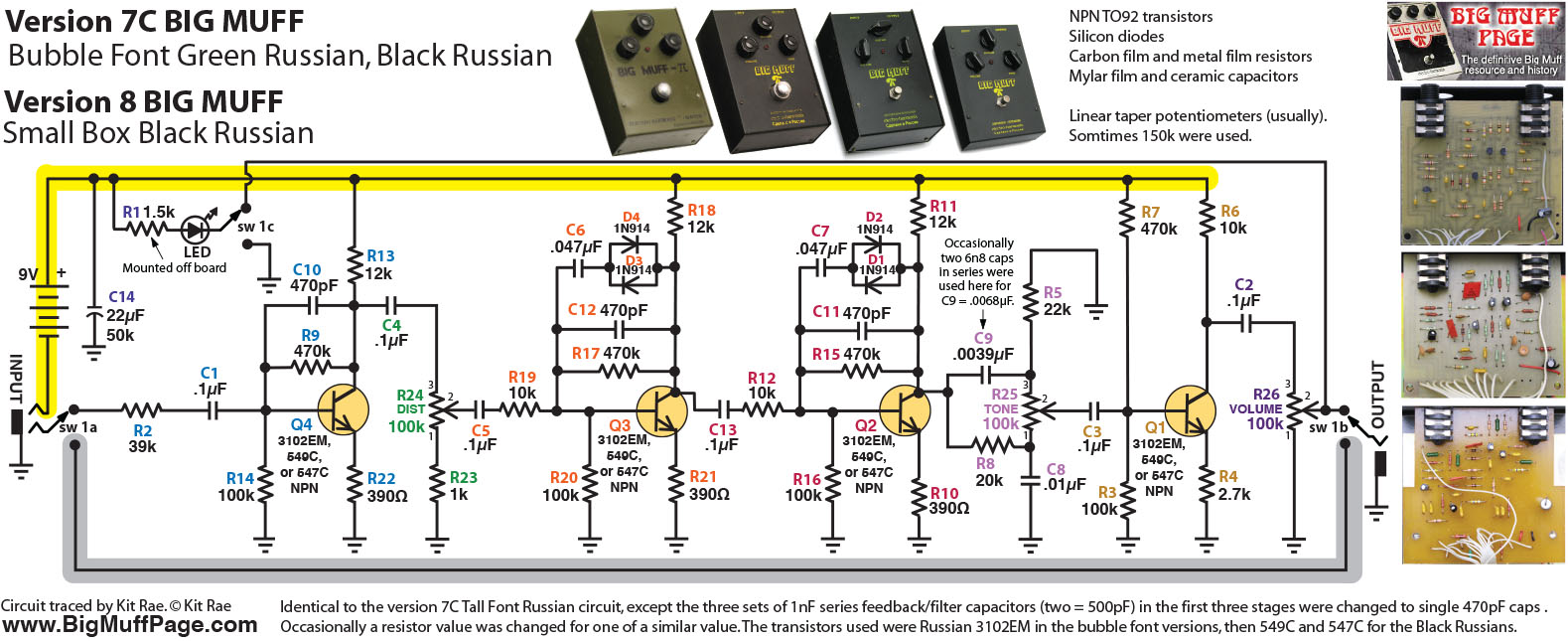
THE ERA OF BIG MUFF MODS and BOUTIQUE CLONES - In the mid 1990s the Big Muff mods that are common today were only just starting to be discussed worldwide on a few internet forums and chat rooms. Pete Cornish was one of the first people known (though unkown to the public at the time) to have been making modified versions of the Big Muff circuit, going as far back as the late 1970s with the first custom Big Muff pedal made for David Gilmour of Pink Floyd, then with his P-2 and G-2 variations in the 1990s. Jeorge Tripps was one of the first to make a BMP clone with a modified tone section in 1995, the Swollen Pickle, also offering a mids switch option. Ron Neeley of Ronsound started offering mods to Big Muffs in the late 1990s. In 1999 Jack Orman (muzique.com) published his A Close Look at the Big Muff & Proco Rat e-book, featuring an in-depth examination of the circuit and several mods. The first highly successful modified BMP clone hit the market in 1999, the Sustain Punch Creamy Dreamer. In 2001 Jack Orman posted his Muff Boost project online, and in 2002 the Muffmaster, both decent booster stages to place in front of the BMP. Jack also posted his AMZ tone/presence control mod in 2002, one of the best tone section mods for the Big Muff. In 2003 Aron Nelson summarized several mods that apply to the BMP circuit on his Simple, Easy Mods/Tips & Techniques page from DIY Stompboxes, including the idea to change the diodes to LEDs, among the many other useful mods.
Ron Neeley of Ronsound started making his own Big Muff clone called the Hairpie in 2003, later adding a mids switch. Marc Ahlfs of Skreddy Pedals began making very popular modified Big Muff clones in 2004, later including a mids switch as a standard feature. Across 2004 and 2005 more and more boutique, hand made BMPs started to appear - Jamie Stillman of Earthquaker Devices created the Hoof pedal, Baja Tech made the Da Moaf, MJM made the Foxey Fuzz, Euthymia made the ICBM, Dice Works made the Muff Diver, and D.A.M. made the Ram Head, among others. In 2005 the Piso-Tones website posted the first collection of Big Muff circuit variant schematics. In 2006 Berarduur (from the old Geekchat website) compiled a great selection of Big Muff specific mods, the Big Muff Pi Mods and Tweaks page, which has become sort of the bible of BMP mods. B.Y.O.C. (Build Your Own Clone) also released the Large Beaver kit in 2006, which was a very versatile, build-it-yourself vintage Big Muff with an adustable tone selector mod. A whole host of new boutique BMP clones continued to appear on the market after this, utilizing these mods or variations of them, many detailed below.
While the reborn Electro-Harmonix company continued to expand and innovate their range of USA Big Muff pedals in the 2000s, dozens and dozens of different BMP clones were being made by dozens of small boutique makers. Many were straight up replicas of vintage BMP circuits, like the superb range offered by Stomp Under Foot, and many were customized variations of the circuit, like those created by Skreddy Pedals. Even the large corporate companies got back into making versions of the BMP, like the Behringer Vintage Distortion and Dunlop Swollen Pickle. Below are schematics of the more popular or interesting takes on the circuit. Apologies to the makers of these modified BMP clones that are in current production (schematics for most of these were already easily available on the web long before I posted these traces of my pedals), and they are all based on pre-existing designs anyway.
PRECISION BIG MUFF / P2 - Pete Cornish, famed effects rig builder, has built a range of rugged, high quality, custom variants of many classic effects, including the P-1 and G-2 Big Muff variants used by David Gilmour of Pink Floyd. Pete was creating his customized takes on the Big Muff long before the electronics community had the internet available to pass ideas back and forth. The P-Fuzz was his second take on the BMP circuit, first used by David Gilmour in his 1988 live rig with Pink Floyd. A different version of the P-Fuzz in a black enclosure was used in Gilmour's 1990 and 1994 rigs. In the late 2000s it was offered for sale to the public, with a built in buffer, and renamed the P-2. The P-2 uses the same pcb as the Cornish G-2, which was another Cornish take on the Big Muff circuit.
This is essentially a modified Big Muff Pi circuit with simplified treble-cut tone control, giving it a brighter mid range than a typical Electro-Harmonix Big Muff.
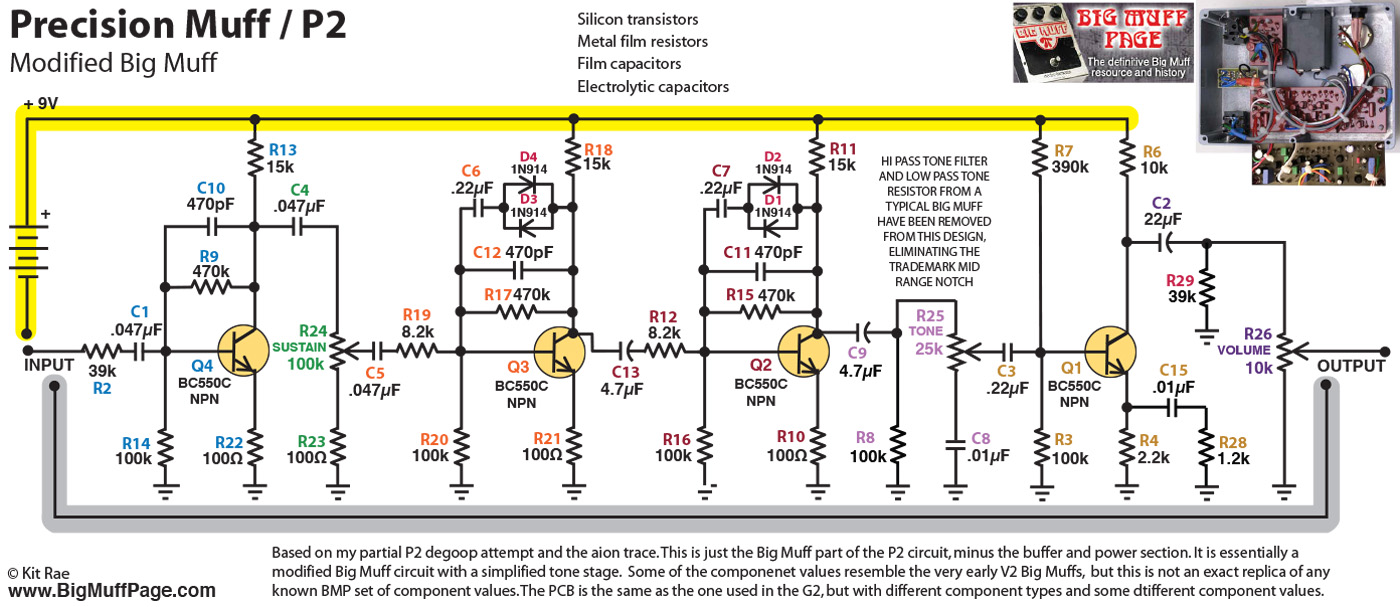
SWOLLEN PICKLE JUMBO FUZZ modified V6 Big Muff - One of the first popular Big Muff clones, and later a popular mod to the BMP circuit, was the Swollen Pickle Jumbo Fuzz (discontinued). The USA Electro-Harmonix factory was long gone by this time, and the old 1970s American made Big Muffs were increasing in value, so it was natural for some DIY makers to start building clones. The Pickle got it's start in 1995 as a hand made modified BMP clone by Jeorge Tripps (Way Huge Electronics). Jeorge made several hundred of these, then Dunlop bought the rights and produced a very different circuit with additional trim pots for a production version around 2008. Note, the schematic below is NOT the current Mark II Swollen Pickle production version made by Dunlop.
Aside from the joke of changing sex of the "Big Muff" name by calling it a "Swollen Pickle", the original Pickle was essentially a V6 era Big Muff clone with a tone section mod. The standard .01µF low pass cap at C8 was changed to .047, and the high pass cap at C9, typically .004, is .0033µF here. This provides what some would say are more 'usable' sounds at the extreme ends of the bass and treble, but but overall it has a deeper mids scoop than normal, for a very mean, dark and heavy tone. There is also an additional trace connecting the high pass tone filter at the C9/R5 junction to the path between C3 and the R7/R3 junction. C9 normally meets the junction at R5 and lug 3 of the tone pot, although I don't think it makes any difference either way. This may not seem like much of a mod these days, but back then altering the mids notch of the BMP tone stack was something unique.
Another unique construction feature of this clone is that it uses a quad transistor chip instead of individual transistors. This offers some noise reduction benefits and more consistent transistor matching than discreet transistors. It also had the benefit in making the circuit appear to be something other than a Big Muff clone. Another version of the Swollen Pickle included a mids switch mod to reduce the mid range scoop, a mod later utilized by Skreddy Pedals. The MkII version made by Dunlop added a two additional mid range controls (scoop and voice) and two distortion/clipping controls (clip and crunch). That version allowed for the same sounds as the original, but also allowed boosting or cutting the mids, and some other tonal possibilities.
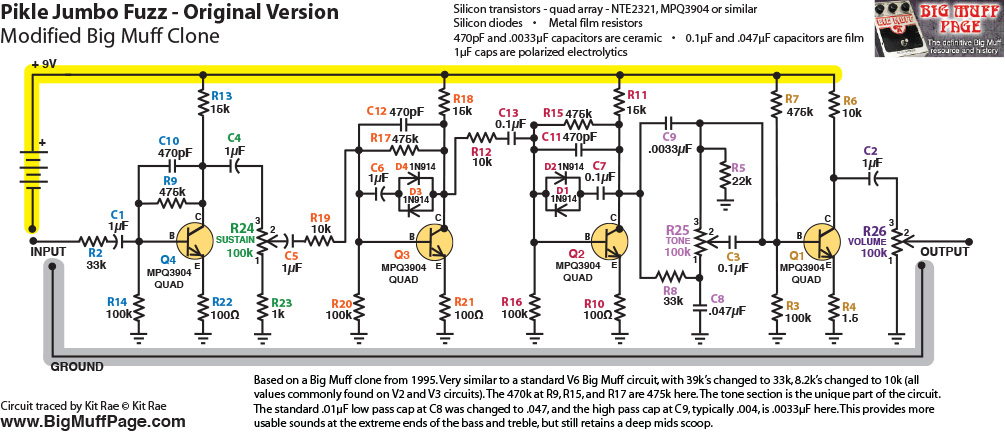
CREAMY DREAMER modified Ram's Head Big Muff - The Creamy Dreamer was a very successful, but short lived modified Big Muff clone made by Jeff Doucette/Sustain Punch in the late 1990s, looseley advertised as a pedal the Smashing Pumpkins used and endorsed (more on that story here.). It seems it was not really endorsed by the band, and its use by the band, if any, is questionable. The hype around it has remained however, and there have been numerous 'creamy dreamer' clones and freely shared mods circulated since this pedal went out of production in 2000. It is generally believed that it was simply a Russian Big Muff clone with emitter lift and limiting resistor mods - but the gooped circuit prevented people from actually tracing it for years, creating some wild speculation about what was actually done. It is finally revealed in all of it's glory here. Well, not so glorious actually, but it is a decent sounding mod.
Looking at the actual circuit I ungooped in my CD, I found it was nothing like Russian Big Muff at all, but very similar to one of the mid '70s Ram's Head variants. I found there was no limiting resistor mod, but the emitter resistors were removed in the first three stages. The tone stage is modified with matching 47k high pass and low pass resistors at R5/R8, flattening the mid scoop out somewhat. Even though there is nothing special about the other component values, pulling those emitter resistors makes for a very high gain Big Muff, and I suppose you could call the EQ from that tone stack 'creamy'. I like it. It is a bit light on the low end for my taste, but that can be remedied by enlarging the clipping caps at C6 and C7 anywhere from .047uF to .1uF, and bringing the feedback filter caps at C11/C12 up to 500pF. (now - you know who you are - you can stop emailing me asking if I have the CD schematic! :)
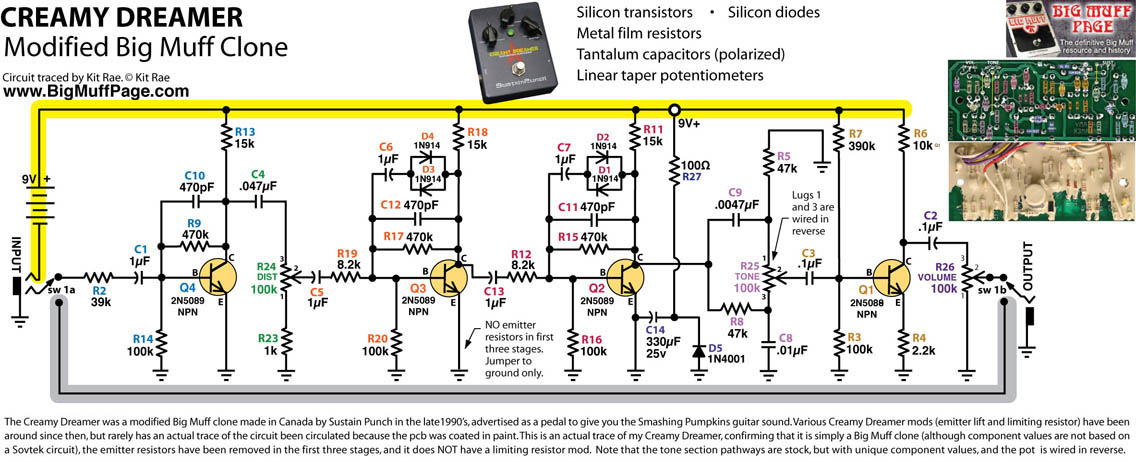
BIG MUFF OVERDRIVE / G2 - Pete Cornish, famed effects rig builder, has built a range of rugged, high quality, custom variants of many classic effects, including the P-1 (Ram's Head based) and P-2 Big Muff variants used by David Gilmour. Pete was creating his customized takes on the Big Muff long before the electronics community had the internet available to pass ideas back and forth. The G-2 was his third take on the BMP circuit, created in the early 1990s for Lou Reed, then sold to the public as a stand alone pedal circa 2002.
This is one of the more unique sounding revisions to the Big Muff circuit, in that it does not sound like a Big Muff at all, but more of a low gain, smooth overdrive. It features some very unusual component values, and trades the Silicon diodes for Germanium. The pedal also included Pete's signature unity gain input/output buffer system for a very clean and balanced signal to your amp. Strip away the buffer components down to the sound circuit and you find the basic Big Muff pathway architecture, with the high pass tone section and part of the low pass removed, and a slightly modified recovery stage (all shown in red). Ge diodes do not compress and distort as much as Si, and they cut the signal level down in the clipping stages, meaning less volume. Pete's blend of component values compensate and take advanatge of that.
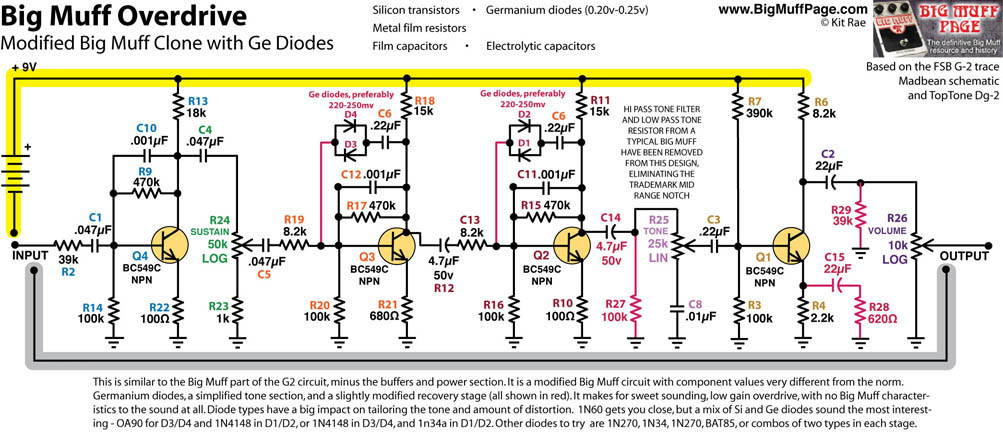
MAYONAISE MUFF WITH MIDS CONTROL Triangle Big Muff clone - The Mayonaise was an exact clone made in 2004 of a 1972 Big Muff variant, similar to the "standard" V1 variant shown on page 1 (V1 67 #1) but with larger collector resistors at R11, R13. Named after the Smashing Pumpkins song, the Mayonaise (discontinued) was made by Marc Ahlfs of Skreddy Pedals. It was the first in a long line of popular Skreddy boutique BMPs. A common feature in the Skreddy muffs (although not on the original Mayonaise) was a mids switch mod to reduce the mid range scoop, included in the Triangle Big Muff schematic below. Values for C9A and C9B can be tweaked to taste. When C9B is switched on, the values of both caps sum to create a larger cap value, and smaller mid range scoop for brighter mids. Another way to control the mids scoop depth is to add a trim pot to the high pass filter, as shown in the two mods below. George Tripps (Way Huge Electronics, Dunlop) was one of the first to use the mids switch mod in the mid 1990's on his Swollen Pickle muff pedal, then Ron Neeley of Ronsound offered this feature on his muffs. Jack Orman (muzique.com) was the originator of Big Muff mids pot mods with his AMZ tone/presence control.
There are also many other interesting mods to the BMP circuit that have been produced by Skreddy Pedals throughout the years.

DICE WORKS MUFF DIVER modified Triangle Big Muff clone - A discontinued boutique clone made by Eric Holden, circa 2006, based on an original Electro-Harmonix V1 Big Muff circuit shown on page 1 (PNP Triangle 72 #2), with larger emitter resistors at R22/R10, and with the addition of switchable coupling caps at C4 (Original Mode) and C5 (Cornish Mode) to make it sound more like the custom Big Muff known as the P-1 that Pete Cornish made for David Gilmour (of Pink Floyd) in the late 1970s. In reality, it sounds nothing like the P-1 when in Cornish mode. It does have a nasally Marshal sound that is reminiscent of some of Gilmour's On and Island tour solo tones from 2006, so perhaps that is where the Cornish inspiration came from. The Cornish mode sounds more like something in between a BK Butler Tube Driver and Cornish G-2 tone, but perhaps a bit too thin and nasally. It does makes for a very versatile Big Muff.
Another version of the Muff Diver called the Finale included a switchable input cap setup, identical to the Cornish/Original switch in the standard Muff Diver version, switchable Ge diodes in the first clipping stage, and a switch to remove the Si diodes from the second clipping stage. That version is a bit of a mismatched mess because volume levels are either too high or too low when switching between the tone modes, but individually the various sounds are nice.
The original PNP Triangle Big Muff variant this was cloned from was one of the first BMP's to be traced and posted on the world wide web. Even though it was actually not a common V1 circuit at all, most boutique BMP clones used this schematic. Still, it sounds very good and defined what people thought a Triangle Big Muff was supposed to sound like in the early days of boutique BMP cloning through the mid 1990's to the early 2000s. The Dice Works Muff Diver, BYOC Large Beaver Triangle V1, General Guitar Gadgets BMP Triangle, and many other Triangle clones were based on this version.
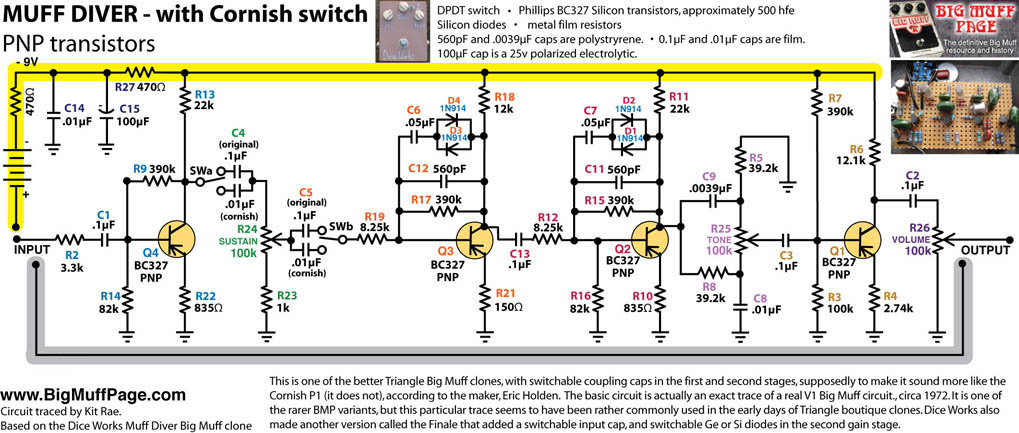
Kit’s Secret Guitar, Gear, and Music Page
Guitar stuff, gear stuff, soundclips, videos, Gilmour/Pink Floyd stuff, photos and other goodies.
Copyright Kit Rae.
VISIT MY SWORDS, KNIVES and FANTASY ART WEBSITE www.kitrae.net
This page is not authorized, affiliated, or associated with Electro Harmonix in any way.
Website and contents ©2007 and ©2012 Kit Rae. All rights reserved. Linking to this website is allowed, but copying the text content is strictly prohibited without prior authorization. No part of this work may be reproduced, stored in a retrieval system, or transmitted in any other form, or by any means, electronic, mechanical, photocopying, recording, computer networking, or otherwise without prior permission in writing from the copyright holder(s).






